Longitudinal research: definition, methodology,methods,characteristics,types, uses,examples and advantages
1.1 Definition
Longitudinal research is a type of observational and correlational methodical investigation which is classified under time data point dimension where by the dimension spreads for a longer period than one such as two, three or several periods. This type of research therefore involves collection of data using more than one data point.
In other words, in longitudinal research, different data is collected from the same unit of observation over a long period. For, instance, collecting data pertaining feeding habit of children as they grow for a period of five years with an aim of comparing their feeding habits. So, it should be noted that, this type of research is correlational in nature for it aids in discovering the relationship between variables in a specific target population.
Again, it should be noted that this type of research relies on both qualitative and quantitative data and survey method is used to collect data from the population of concern. During data collection, the researcher does not interfere with those involved in the survey as participants. Instead, he or she will distribute the questionnaires (for primary data) or data collection forms (secondary data) to collect data over a lengthy period pertaining changes in behavior or attitude of the participants.
1.2 Classification of Longitudinal Research
There are basically three categories of longitudinal research. These are: -
1.2.1 Time Series Research
The case of time series research, as the name suggests, it is longitudinal research which entails observing or collecting data for more than one unit of analysis (that is a group of firms either in the same industry or sub-sector (population)) relating to only one variable, such as financial performance for several number of periods (i.e., more than one data point).
Example
Observation of characteristics of sales for ten (10) fruit processing firms in the manufacturing industry in USA for the period between 2011 and 2016. So, the data collected will be as follows as per Table 1.1;
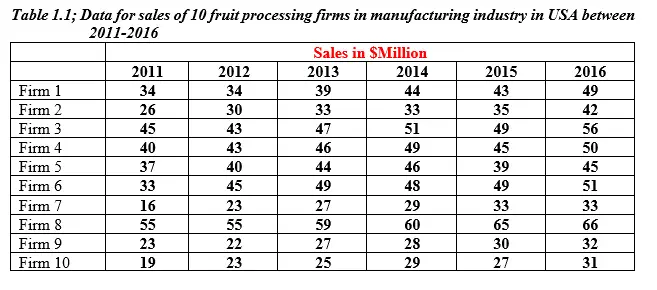
Clarification-you can see this is observation of only One Variable (sales levels) for similar groups such as firms in the same industry for several periods. This is a case of Time Series. To differentiate it from the other two, I call it n-1-t. That is the study is targeting more than one unit of analysis (nth), for one variable (1) for more than one period (i.e., more than one data point (t.th).
In Summary:
Time Series Research focus on More than One Unit of Analysis for One Variable for More than One Period (i.e., More than One Data Point). See Figure1.1
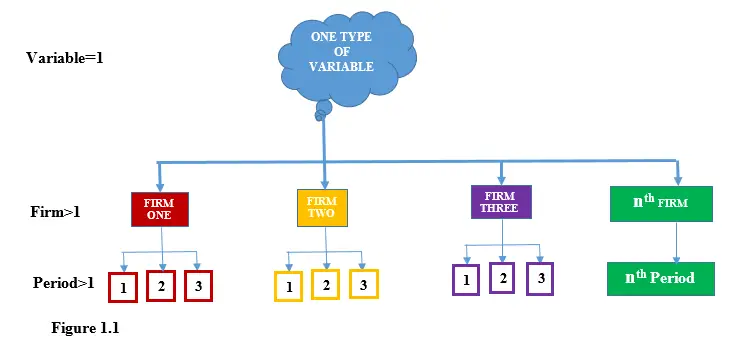
1.2.2 Panel Research
Panel research is a type of longitudinal research which entails sampling a cross-section of unit of observations at specific intervals for a longer period. In the case of panel research, as the name suggests, it is longitudinal research which entails observing or collecting data for several similar units of analysis for Several Variables, let say firm size, number of employees, and sales growth rate for several number of periods under study. That is a group of units of analysis in either the same industry or sub-sector.
This type of research measures the subject matter’s behaviors over time. For instance, participants’ opinions, feelings, emotions and suggestions. Panel studies are a type of prospective study for data collected is for the past period or historical data.
Example
Observation of THREE variable characteristics namely; firm size, number of employees, and sales growth rate for IT industry firms, namely; A, B, C, and D in United Kingdom, for five (5) periods between 2016 and 2020. So, the data collected will be as follows;

Clarification-you can see this is observation of more than one variable (size, employ & sales) for several similar groups such as firms in the same industry for several periods. This is a case of panel research. To differentiate it from the other two, I call it n-n-n or (n3). For there are more than one unit of analysis (nth-unit of analysis), more than one variable (nth-variable), and more than one period (nth-data points).
In summary:
Panel Data Research focus on More than One Unit of Analysis for More than One Variable for More than One Period (i.e., More than One Data Point). See Figure1.2
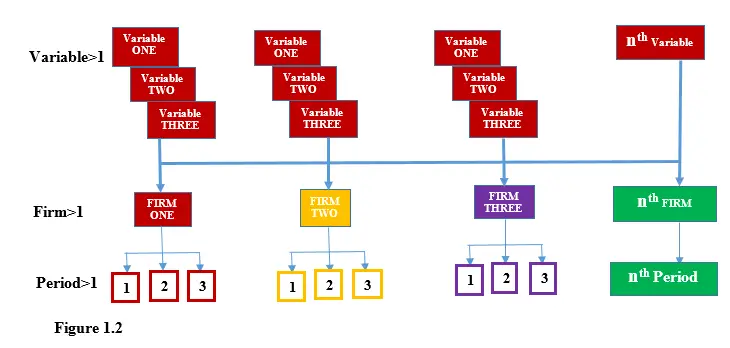
Applicability of Panel Research
When to Use Panel Study?
It is used if and only if one wants to get straight forward facts about the changes in a sample.
Advantages of Panel Study
- It is appropriate in identifying the factor(s) causing or prompting changes that are observed on the dependent variable.
- It helps the researcher to do impact assessment of the change introduced on the study variable. This is because panel research takes a longer period in observing the subject matter, at least there is enough time to assess the influence or impact thereof unlike the case of cross-sectional study.
- It helps the researcher to do correlation assessment of the time aspect on the study variable. The reason being that panel research takes a longer period in observing the subject matter, at least there is enough time to assess the influence or impact time factor has over the subject matter under interrogation.
- Source of historical data from the sample population. With continuous recording of character of the respondent over time, this information collected builds up the historical data.
Disadvantages of Panel Studies
- This study is expensive in terms of resources needed.
- Time consuming. Conducting a panel study consumes a lot of time for obviously it is long term activity.
- Lack of uniform quality information-the assumption that data will be collected from normal conditions may not be the case for the timespan is too long. Hence it is clear that circumstances must have changed and may be the respondent character changed too.
1.2.3 Cohort Research
This is a type of longitudinal investigation which entails sampling or selecting one unit of analysis to collect data with several variables that concern that subject matter for a longer period. For example, the research involves observing or collecting data of several variables, let’s say firm size, number of employees, and sales growth rate for one group chosen from the population.
This type of research considers only one unit of analysis from the population based on a particular criterion such as experience such as geographical location, or historical experience. Cohort research can be of retrospective nature if data collected is for an event which have already occurred or is found in an existing databank.
Therefore, for the case of cohort research, as the name suggests, it is longitudinal research which entails observing or collecting data of several variables, let say firm size, number of employees, and sales growth rate of only one unit of analysis for more than one period. That is observing data of firm size, number of employees, and sales growth rate for one firm for several periods.
Example
Observation of three (3) variable characteristics, namely; firm size, number of employees, and sales growth rate for Mega co Ltd in Canada for five (5) periods between 2016 and 2020. So, the information will be presented as follows;
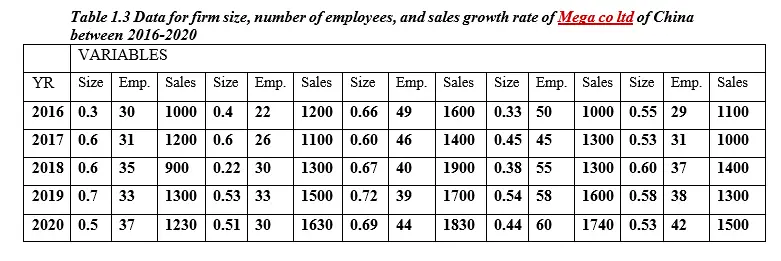
In summary:
Cohort Research focus on One Unit of Analysis for More than One Variable for More than One Period (i.e., More than One Data Point). See Figure1.3
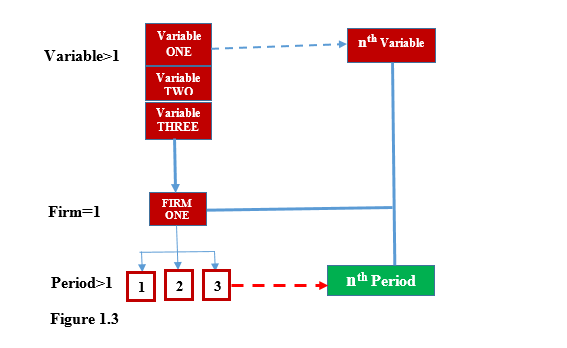
Applicability of Cohort Research
When do we use Cohort Study?
Used if and only if the researcher is investigating on the cause-effect relationship within the data sets. For example, in medicine a researcher is investigating the causes of a particular disorderliness and relate the disorderliness and the factor causing it thereof.
Advantages of Cohort Studies
- Possible to realize more than one outcome from the same subject matter caused by one causing factor.
- Cohort studies enables the researcher to gauge all study variables of concern.
-
Disadvantages of Cohort Studies
- Cohort study is expensive to conduct.
- Researcher has no control of the study variable. The researcher has less control over variables for he or she just observes the behavior from far.
Longitudinal research methodology
2.1 Definition
Longitudinal Research Methodology is the logical process or step by step blueprint or design on how to solve a research problem that calls for observing the research participants throughout the study and recording any changes in behaviors or qualities that the researcher notices.
2.1.1 Questions Longitudinal Research Methodology tries to Answer
The aim of Longitudinal research is to answer questions related to what and how of a certain condition, conviction or a situation on the ground.
The following matrix portrays the link between Longitudinal type of research and the type of research methodology adopted and then an explanation of the logical approach associated with this category and then in the last column, the research method(s) used in formulating the research problem as per Table 1.4.
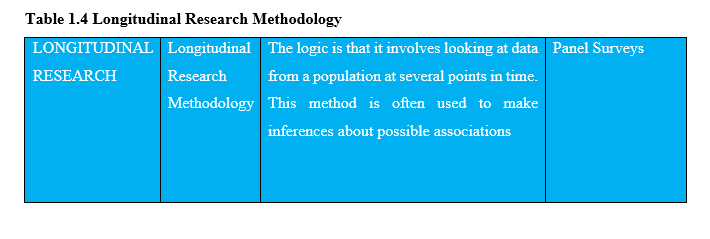
2.2 Research Methodology-Diagrammatic Approach
The following diagram represents a summary of logical roadmap to be adhered to in Longitudinal research methodology
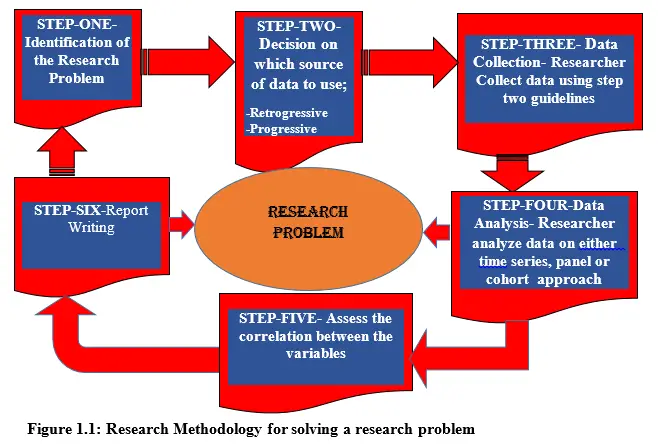
The following logical steps describe the Longitudinal Research methodology. From step one to six, it represents a logical way of how systematically the subject matter need to be dealt with. Remember that in this approach, the researcher is concerned with whether there is any correlation between the two variables.
Step 1: Identification of the Research Problem
Under research problem, the researcher is concerned of whether there exists any relationship or correlation between two variables. So, he/she wants to infer if there is an association although it may not be sufficient enough to guarantee a direct cause. In case of existence of any element of a link between the two variables.
Step 2: Make Decision on the nature of source of data to use
With the research problem in mind, the researcher identifies the population in question so as to undertake his/her investigation. At this stage, the researcher follows the study to assess the exposure and the outcomes as per the proclamation. This is the stage where by the researcher need to choose retrogressive data which is naturally historical or from the databank or progressive data which is current in nature.
Step 3: Data Collection
At the stage of data collection, the researcher needs to choose the approach or method to use for there are two approaches;
i). Retrogressive data collection
In the case of retrogressive data collection, data collected is of secondary nature. That is, already data which has been collected for a particular event or behavior by another person and kept in databank. Example of such data is financial performance data for a firm for the last 5 years.
ii). Progressive data collection
This approach of data collection is real time. In other words, the researcher collect data as the event takes place. Prospective studies are more common for social sciences research. The approach of collecting data entails identifying how, when, where, and on whom the data will be collected from.
The researcher therefore maintains only one procedure of collecting data over time to uphold the validity of the observation being made.
The researcher subjects all the units of observation under the same conditions for comparison purposes. Data is collected with caution to avoid much observational variability.
Step 4: Data Analysis
In this step, data is analyzed to establish whether there exists any correlation between the variables. This is achieved by either, one; using time series data analysis approach whereby there are many units of analysis with a common variable (one) under investigation for more than one period of time. Two; using panel data. This is achieved by using data analysis approach whereby there are more than one unit of analysis with more than one common variable(one) under investigation for more than period of time. Or cohort analysis can be relied upon whereby the study focus on only one unit of analysis with more than one variable (one) under investigation for more than one period of time.
Step 5: Assess the Correlation Between the Variables
The researcher assess the nature of correlation between the variables, whether strong or weak link exists so as to be able to interpret the nature of the relationship thereof.
Step 6: Report Writing
The last step is that of reporting the research findings and it is very simple. Either to provide evidence that there exists correlation or not.
Longitudinal research methods
Research methods are all the techniques that are utilized in all the stages of research processes. They are tools used to ensure the end results of research task are accomplished. These techniques vary from one stage of research process to another. These methods are further classified in to two categories, namely;
a) Pre-Data analysis methods
b) Data Analysis related methods
As per Table 1.4 in this article, Longitudinal research method indicated in that table (refer), namely; panel Surveys method is for the purposes of formulating the research problem and is one of the methods which fall under pre-data analysis category. However, in this discussion of Longitudinal research, we will focus on data collection methods on one side, referring to primary data such as surveys, observations psychometric instruments, Histories and on the other hand secondary data such as which are also pre-data analysis in nature. That is; observation, survey and case study.
Survey Method
Survey approach of collecting data entails use of data collection tools such as personal structured interview, mail questionnaires, telephone surveys, diaries, tests and instruments.
Observation Methods
This is a method which involves the researcher collecting data from the subject matter using direct observation. In this case, the researcher does not manipulate the variables.
Secondary Data collection method
Secondary data collection method or approach is a way of collecting data whereby the researcher is indirectly involved for he/she uses data in store.
Diaries Data Collection Methods
This is also another approach of collecting data. It has been a common way of collecting data in the qualitative spheres The diary involves the standard tasks of any research project reviewing past literature and identifying research questions, then designing and carrying out a data collection.
Types of Diary Collection Methods
The type of diary that exists is dictated by the nature of use or discipline the researcher is affiliated to. These types of diaries include
- Time diaries. These is a method of data collection where by the respondent records his or her experience in the presence of a certain condition and out of the same condition for comparison purposes over time. For instance, the investigator may ask two groups with different experience to fill a diary so as to compare them.
- Travel diary. This is often used by transport planning researchers to provoke data in respect to travelling characteristics. For instance, travelers are requested to record their own travelling experience for every trip they make with the intension of adding more detailed survey data.
- Heath affiliated diaries-such as food-diary
A food dairy can be used to assess the sugar level of a patient to find out the effectiveness of the sugar level control tablets used by the researcher on the respondents. Or data may be recorded in a diary to investigate the eating patterns of healthy and ill stricken patient.
Repository Analysis
Repository analysis approach involves researcher using data already collected and deposited in a databank. The data could have been collected by a third party for a different purpose but it can again be accessible to other researchers.
Characteristics of longitudinal research
- It is non-disturbing to the unit of observation. That is, the researcher collects data in a natural manner such that he/she simply record down what he observes. The researcher allows the respondent to operate freely so as to learn the behavior thereof. In other words, the researcher does not control the subject matter.
- Dominated by both qualitative and quantitative questions-the researcher administers a survey with both qualitative and quantitative nature of questions.
- Observation oriented. Data collection is through physical observation of character or behavior from the subject matter in its natural phenomenon.
- Timespan. Longitudinal research covers a wider or longer period of time such as weeks, months or per annum or several years.
Advantages of longitudinal research
- Validation.Because of the researcher carrying out continuous observations for a long period of time, any conclusions or results observed are truly authenticated to be true. For one can confirm and re-affirm a behavior/character.
- Unique data. Longitudinal research provides special data for the data set is as a result of observation undertaken for a long period of time which is long enough to assure one of the validity perspectives. This is contrary to if data is collected within a shorter period.
- Easy to trace existing trends of a particular variable. The researcher is able to identify the pattern or movement of the study variable because there is enough time for the variable to portray its character.
- Flexibility.Longitudinal surveys are not rigid for it provides room for alterations of the specific data point, which can aid in showing unforeseen patterns or associations that can be significant. This flexibility is made possible for the time span is lengthy.
- Collection of additional data to study unexpected findings. Because of continuously collecting more and more data over a long period of time, it is possible to discover new research findings.
Disadvantages of longitudinal research
- Data obsolescence.
- Longitudinal research involves the design of collecting data for a long period which may end up being useless for it can be overtaken by events. For instance, it may take several years before the data collected is analyzed to show the relationship thereof. As a result, other issues may have cropped in and interrupt the expectations.
- Loss of sample. The original sample may be lost over time for the time duration is always too long such that by the time analysis is being done the original data has lost validity.
- Loss of research participants. Longitudinal research is naturally too long such that some participants may lose patience and quit the exercise hence the sample size may end up not being a true representation of the population in the long run.
- Costly.It is expensive to carry out longitudinal surveys for the long-time span nature may result to skyrocketing of the resources needed due to inflation.
- Inappropriate conclusion. Because, the study takes a long period, the research findings may be inconclusive and misleading
Difference between longitudinal and cross-sectional research
What is the Difference between longitudinal and Cross-sectional research? The Table 1.5 below portrays the difference
